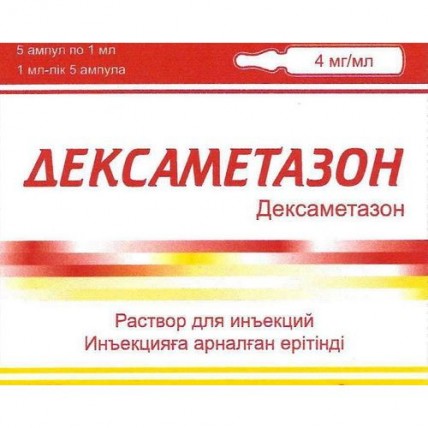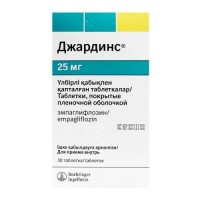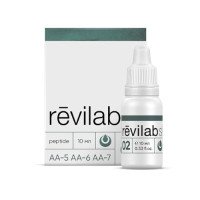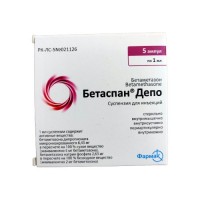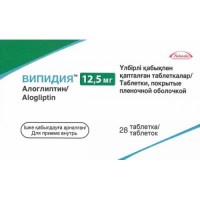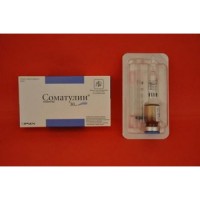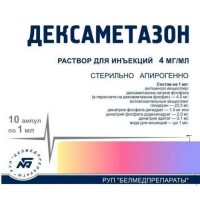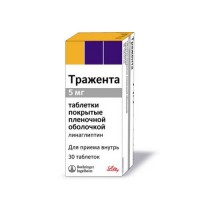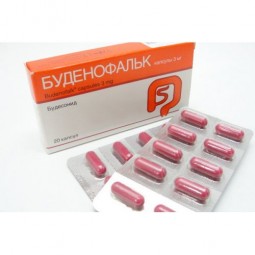Dexamethasone 4 mg / ml solution for injection 25's
- $17.40
The instruction for medical use
of medicine
Dexamethasone
the Trade name
Dexamethasone
the International unlicensed
name Dexamethasone Dosage Form Solution for injections, 4 mg/ml, 1 ml
Structure
of 1 ml of drug contains
active agent - dexamethasone sodium phosphate (it is equivalent to dexamethasone to phosphate) 4.37 mg (4.00 mg),
excipients: creatinine, sodium citrate, dinatrium edetat a dihydrate, 1 M hydroxide sodium solution, water for injections.
The description
Transparent colourless or weak-brown color solution
Pharmacotherapeutic group
Corticosteroids for system use. Glucocorticosteroids.
Dexamethasone.
The ATX H02AB02 code
the Pharmacological
Dexamethasone Pharmacokinetics properties phosphate belongs to is long to the operating glucocorticosteroids. After intramuscular introduction it is quickly absorbed from the place of an injection and with a blood flow it is distributed in fabrics. About 80% of drug contact proteins of blood plasma. Well gets through hematoencephalic and other gistogematichesky barriers. The maximum concentration of dexamethasone in liquor is observed in 4 h after intravenous administration and makes 15-20% of concentration in blood plasma. After intravenous administration the specific action is shown in 2 h and lasts for 6-24 h. Dexamethasone is metabolized in a liver much more slowly than a cortisone. Elimination half-life (T12) from blood plasma – about 3-4.5 h. About 80% of the entered dexamethasone eliminirutsya by kidneys in the form of a glucuronide for 24 h.
Pharmacodynamics
Synthetic glucocorticoid drug. Renders expressed the anti-inflammatory, antiallergic and desensibilizing action, has immunosuppressive activity. Slightly detains sodium and water in an organism. These effects are connected with release oppression by eosinophils of mediators of inflammation, induction of formation of lipokortin and reduction of quantity of the mast cells producing hyaluronic acid with reduction of permeability of capillaries, oppression of activity of cyclooxygenase (mainly TsOG-2) and synthesis of prostaglandins, stabilization of cellular membranes (especially lizosomalny). The immunosuppressive effect is caused by slowing down of release of cytokines (interleukin-I, II, gamma interferon) from lymphocytes and macrophages. The main influence on a metabolism is connected with catabolism of proteins, increase in a gluconeogenesis in a liver and decrease in utilization of glucose peripheral fabrics. Drug suppresses activity of vitamin D that leads to decrease in absorption of calcium and increase in its removal from an organism. Dexamethasone suppresses synthesis and secretion of adrenocorticotropic hormone and again – synthesis of endogenous glucocorticoids. Feature of effect of drug is considerable oppression of function of a hypophysis and total absence of mineralokortikoidny activity.
Indications
- shock of various genesis (anaphylactic, posttraumatic, postoperative, cardiogenic, hemotransfusionic, etc.)
- brain hypostasis (in brain tumors, a craniocereberal injury, neurosurgical operations, a cerebral hemorrhage, meningitis, encephalitis, radiation injuries)
- the asthmatic status
- heavy allergic reactions (a Quincke's edema, a bronchospasm, a dermatosis, acute anaphylactic reaction on medicines, serum transfusion, the pyrogenous reactions)
- acute hemolytic anemia
- thrombocytopenia
- an agranulocytosis
- acute lymphoblastoid leukemia
- serious infectious diseases (in a combination with antibiotics)
- acute insufficiency of bark of adrenal glands
- diseases of joints (humeroscapular periarthritis, an epicondylitis, a bursitis, a tendovaginitis, osteochondrosis, arthritises of various etiology, an osteoarthrosis)
- rheumatoid diseases
- collagenoses
Dexamethasone, solution for injections, 4 mg/ml, are used at acute and medical emergencies at which parenteral administration is vital. Drug is intended for short-term use according to vital indications.
The route of administration and doses
the Mode of dosing is individual and depends on indications, disease severity and reaction of the patient to therapy. The drug is administered intramusculary, intravenously slowly struyno or by drop infusion, also periartikulyarny or intra articulate introduction is possible. For the purpose of preparation of solution for in in drop infusion it is necessary to use isotonic solution of sodium of chloride, 5% solution of glucose or Ringera solution.
The adult intravenously, intramusculary enter from 4 to 20 mg of 3-4 times/days. The maximum daily dose makes 80 mg. At critical life-threatening situations high dosages can be necessary. Duration of parenteral use is 3-4 days, then pass to maintenance therapy with an oral form of drug. At achievement of effect a dose reduce for several days to achievement of a maintenance dose (on average 3-6 mg/days depending on disease severity) or before the termination of treatment at continuous observation of the patient. Fast intravenous administration of massive doses of glucocorticoids can cause cardiovascular collapse: the injection is made slowly, within several minutes.
Wet brain (adult): an initial dose of 8-16 mg intravenously, in the subsequent 5 mg intravenously or intramusculary every 6 hours before achievement of satisfactory result. At surgeries on a brain these dosages can be necessary some more days after operation. After that the dosage has to decrease gradually. Continuous treatment can counteract the increase in intracranial pressure connected with a brain tumor.
To children appoint intramusculary. The drug dose usually makes from 0.2 mg/kg to 0.4 mg/kg a day. Treatment has to be reduced to the minimum doses during most shortest span. At intra articulate introduction the dose depends on extent of inflammation, the size and location of the struck area. The drug is administered once in 3-5 days (for a synovial bag) and once in 2-3 weeks (for a joint).
Small joints
of 0.6 mg up to 0.8 mg
the Synovial bag
of 1.6 mg up to 3.0 mg
the Vagina of a sinew
of 0.3 mg up to 0.8 mg
In the same joint to enter big joints of 1.6 mg up to 3.0 mg no more than 3-4 times no more into 2 joints at the same time. More frequent administration of dexamethasone can injure a joint cartilage. Intra articulate injections have to be carried out in strictly sterile conditions.
Side effects
Usually Dexamethasone is well transferred. It has low mineralokortikoidny activity: its influence on water and electrolytic exchange is small. As a rule, low and average doses of Dexamethasone do not cause a delay of sodium and water in an organism, the increased potassium excretion.
At single introduction
- nausea, vomiting
- arrhythmias, bradycardia, up to cardiac arrest
- arterial hypotension, collapse (especially at fast introduction of high doses of drug)
- decrease in tolerance to glucose
- decrease in immunity
At long therapy
- steroid diabetes or a demonstration of latent diabetes, oppression of function of adrenal glands, an Icenco-Cushing syndrome, a delay of sexual development at children, dysfunction of sex hormones (disturbance of a menstrual cycle, an amenorrhea, a hirsutism, impotence)
- pancreatitis, steroid ulcer of stomach and duodenum, an erosive esophagitis, gastrointestinal bleedings and perforation of a wall of digestive tract, increase or a loss of appetite, digestion disturbance, a meteorism, a hiccups, in rare instances - increase in activity of hepatic transaminases and alkaline phosphatase, a hepatomegalia
- myocardium dystrophy, development or strengthening of severity of heart failure, changes on the electrocardiogram, characteristic of a hypopotassemia, increase in arterial blood pressure, hypercoagulation, fibrinferments. Patients with an acute and subacute myocardial infarction have a distribution of the center of necrosis, delay of forming of cicatricial fabric that can lead to a rupture of a cardiac muscle
- a delirium, a disorientation, hallucinations, manic-depressive psychosis, a depression, paranoia, increase in intracranial pressure with a papilledema (the brain pseudoneoplasm — is more often at children, usually after too fast reduction of a dose, symptoms — a headache, deterioration in visual acuity or doubling in eyes), exacerbation of epilepsy, mental dependence, concern, sleep disorders, dizziness, a headache, spasms, amnesia, cognitive disturbances
- increase in intraocular pressure, glaucoma, a papilledema, a back subkapsulyarny cataract, thinning of a cornea or sclera, exacerbation of bacterial, fungus or viral diseases of eyes, an exophthalmos, sudden loss of sight (at parenteral administration the adjournment of crystals of drug in eye vessels)
- the increased calcium removal, a hypocalcemia, increase in body weight, negative nitrogenous balance, the increased perspiration
- a delay of liquid and sodium (peripheral hypostases), a hypernatremia, a gipokaliyemichesky alkalosis
- delay of growth and processes of ossification at children (premature closing of epiphyseal regions of growth) is possible, osteoporosis (it is very rare - pathological bone fractures, aseptic necrosis of a head humeral and a femur), a rupture of sinews of muscles, a proximal myopathy, decrease in muscle bulk (atrophy). Strengthening of pain in a joint, swelling of a joint, painless destruction of a joint, Sharko's arthropathy (at intra articulate introduction)
- the slowed-down healing of wounds, petechias, ecchymomas, thinning of skin, hyper - or hypopigmentation, steroid eels, striya, tendency to development of a pyoderma and candidiases
- hypersensitivity, including an acute anaphylaxis, local allergic reactions - skin rash, an itching. Passing burning or pricking in a crotch after an intravenous injection of high doses of corticosteroids phosphates
local at parenteral administration: burning, numbness, pain, pricking in the injection site, an infection in the injection site, is rare - necrosis of surrounding fabrics, formation of hems in the place of an injection, an atrophy of skin and hypodermic cellulose at introduction in oil (introduction to a deltoid muscle is especially dangerous)
- development or exacerbation of infections (in common applied immunodepressants and vaccination promote), a leukocytosis, a leukocyturia, rushes of blood to the person, a withdrawal, risk of a thrombogenesis and infections.
Contraindications
- hypersensitivity to dexamethasone or auxiliary components of drug
- a system infection in case specific antibacterial therapy is not used
- for periartikulyarny or intra articulate introduction: the previous arthroplasty, pathological bleeding (endogenous or caused by use of anticoagulants), an intra joint bone fracture, infectious (septic) inflammatory process in a joint and periartikulyarny infections (including in the anamnesis) and also the general infectious disease, bacteremia, a system fungal infection, the osteoporosis expressed circumarticular, lack of signs of inflammation in a joint (a 'dry' joint, for example in an osteoarthrosis without synovitis), the significant bone destruction and deformation of a joint (sharp narrowing of an articulate crack, an anchylosis), instability of a joint as an arthritis outcome, aseptic necrosis of the epiphyses of bones forming a joint, infections in the place of an injection (for example, septic arthritis owing to gonorrhea, tuberculosis).
At children during a growth period the glucocorticosteroids have to be applied only according to absolute indications and under especially careful observation of the doctor.
With care
the Special attention is required by consideration of a question of use of system corticosteroids at patients with the following diseases and states, at the same time frequent control of a condition of the patient is necessary:
- arterial hypertension, stagnant heart failure
- Cushing's syndrome
- acute psychosis or cases of heavy affective disorders (especially previous steroid psychoses)
- a renal failure
- a peptic ulcer of a stomach and duodenum
- a liver failure
- active and latent tuberculosis as glucocorticoids can cause reactivation
- osteoporosis
- diabetes (or hereditary burdeness on diabetes)
- system mycoses
- infectious damages of joints
- obesity of the III-IV article
- glaucoma (or hereditary burdeness on glaucoma)
- the previous kortikosteroidindutsirovanny myopathy
- epilepsy
- migraine
- parasitic invasions, in particular, an amebiasis
- immunodeficiency
Medicinal interactions
Is possible pharmaceutical incompatibility of dexamethasone with others in/in the administered drugs - it is recommended to be entered separately from other drugs (in/in bolyusno, or through other dropper as the second solution). At dexamethasone solution mixing with heparin the deposit is formed.
Co-administration of dexamethasone with:
- inductors of liver microsomal enzymes (barbiturates, carbamazepine, Primidonum, rifabutin, rifampicin, Phenytoinum, phenylbutazone, theophylline, ephedrine, barbiturates) easing of effects of dexamethasone owing to increase in its removal from an organism
- diuretics is possible (especially thiazide and inhibitors of a karboangidraza) and Amphotericinum B - can lead to strengthening of removal from an organism of potassium and increase in risk of developing heart failure
- natriysoderzhashchy drugs - to development of hypostases and increase in arterial blood pressure
- cardiac glycosides - their shipping worsens and the likelihood of development of a ventricular ekstrasitoliya (because of the caused hypopotassemia)
- indirect anticoagulants raises - weakens (strengthens) their action less often (dose adjustment is required)
- anticoagulants and trombolitika - risk of developing bleedings from ulcers in a GIT
- ethanol and NPVP increases - the risk of developing of erosive cankers in a GIT and development of bleedings amplifies (in a combination with NPVP at treatment of arthritises the dose decline of glucocorticosteroids because of summation of therapeutic effect is possible). Indometacin, forcing out dexamethasone from communication with albumine, increases risk of development of its side effects
- paracetamol - risk of development of hepatotoxicity (induction of liver enzymes and formation of a toxic metabolite of paracetamol)
- acetylsalicylic acid increases - accelerates its removal and reduces concentration in blood. At reception of corticosteroids the renal clearance of salicylates increases therefore cancellation of kortikosterid can lead to organism intoxication salicylates
- insulin and oral hypoglycemic drugs, antihypertensives - their efficiency
- vitamin D decreases - its influence on absorption of Sa2 + in intestines
- somatotropic hormone decreases - reduces efficiency of the last
- M-holinoblokatorami (including antihistaminic drugs and tricyclic antidepressants) and nitrates - promotes increase in intraocular pressure
- an isoniazid and meksiletiny - increases their metabolism (especially at 'slow' atsetilator) that leads to decrease in their plasma concentration.
Inhibitors of a karboangidraza and 'loopback' diuretics can increase risk of developing osteoporosis.
AKTG strengthens effect of dexamethasone.
Ergocalciferol and parathormone interfere with development of the osteopathy caused by dexamethasone.
Cyclosporine and ketokonazol, slowing down dexamethasone metabolism, can increase in some cases its toxicity, increases risk of developing spasms at children.
Co-administration of androgens and steroid anabolic drugs with dexamethasone contributes to the development of peripheral hypostases, a hirsutism, appearance of eels.
Are oestrogenic and oral estrogensoderzhashchy contraceptives reduce clearance of dexamethasone that can be followed by strengthening of expressiveness of its action.
Mitotanum and other inhibitors of function of bark of adrenal glands can cause need of increase in a dose of dexamethasone.
At simultaneous use with live antiviral vaccines and against the background of other types of immunization increases risk of activation of viruses and development of infections.
Antipsychotic means (neuroleptics) and Azathioprinum increase risk of developing a cataract when prescribing dexamethasone.
At simultaneous use with anti-thyroid drugs decreases, and with thyroid hormones - the clearance of dexamethasone increases.
At simultaneous use with the drugs increasing metabolic clearance of glucocorticoids (ephedrine and aminoglutethimide) the reduction or oppression of effects of dexamethasone is possible, with carbamazepine - reduction of effect of dexamethasone is possible, with imatiniby - reduction of concentration of an imatinib in blood plasma owing to induction of his metabolism and increase in removal from an organism is possible.
At simultaneous use with antipsychotic means, bukarbany, risk of developing a cataract arises Azathioprinum.
At simultaneous use with a methotrexate - strengthening of hepatotoxicity is possible, with prazikvantely - reduction of concentration of a prazikvantel in blood is possible.
Immunodepressants and cytostatics strengthen effect of dexamethasone.
Special instructions
In post-market researches it was reported about very exceptional cases of development of a syndrome of lysis of a tumor in patients with hemoblastoses after use of only one dexamethasone or in a combination with other chemotherapeutic means. Patients with high risk of development of a syndrome of lysis of a tumor have to be under fixed control and the appropriate measures of precaution have to be taken.
Patients and/or trustees have to be warned concerning a possibility of development of serious side effects from mentality. Symptoms are usually shown within several days or weeks after an initiation of treatment. The risk of emergence of these side effects is higher at use of high doses / systematic influence though the level of a dose does not allow to predict approach, weight or duration of reaction. The majority of reactions disappear after reduction of a dose or drug withdrawal though specific treatment sometimes is necessary. Patients and/or trustees have to see a doctor if psychological symptoms disturb, in particular a depression, suicide thoughts though such reactions
are registered not often. The special attention is required by a question of use of system corticosteroids for patients with the heavy affective disorders existing or available in the anamnesis which include depressive, manic-depressive psychosis, the previous steroid psychosis - treatment is carried out only according to vital indications.
After parenteral purpose of glucocorticoids, serious anaphylactic reactions, such as laryngeal edema, small tortoiseshell, bronchospasm can be observed, is more often at patients with an allergy in the anamnesis. At emergence of anaphylactic reactions it is necessary to carry out the following measures: urgently intravenous slow administration of 0.1-0.5 ml of adrenaline (solution 1: 1000: 0.1 – 0.5 adrenaline mg depending on body weight), intravenous administration of Aminophyllinum and if it is necessary - artificial respiration.
Side effects can be reduced when assigning minimal effective doses at short notice and by introduction of a daily dose once in the morning. It is necessary to titrate to a thicket a dose depending on activity of a disease.
Patients with craniocereberal injuries or a stroke should not appoint glucocorticoids as it will not bring benefit and can even be harmful.
In diabetes, tuberculosis, bacterial and amoebic dysentery, arterial hypertension, tromboemboliya, a heart and renal failure, nonspecific ulcer colitis, a diverticulitis, recently formed anastomosis of intestines it is necessary to apply Dexamethasone very carefully and at adequate treatment of a basic disease.
At sudden drug withdrawal, especially in case of use of high doses, there is a withdrawal of glucocorticosteroids: anorexia, nausea, block, generalized musculoskeletal pains, general weakness. Too fast dose decline after long-term treatment can result in acute adrenal insufficiency, arterial hypotension, death. After drug withdrawal for several months the relative insufficiency of bark of adrenal glands can remain. If during this period there are stressful situations, appoint temporarily glucocorticoids, and if necessary – mineralokortikoida.
Before use of drug it is desirable to perform examination of the patient on presence of ulcer pathology of digestive tract. Patients with predisposition to development of this pathology need to appoint antiacid means with the preventive purpose.
During drug treatment the patient has to adhere to the diet rich with potassium, proteins, vitamins, with the reduced content of fats,
carbohydrates and sodium.
As a result of suppression by dexamethasone of inflammatory reaction and immune function the susceptibility to an infection increases. In the presence at the patient of intercurrent infections, a septic state the treatment by Dexamethasone needs to be combined with antibacterial therapy.
Chicken pox can lead to a lethal outcome at patients with immunosuppression. The patients who did not have chicken pox should avoid close personal contact with patients with chicken pox or the surrounding herpes, and in case of contact to ask for urgent medical care.
Measles: patients should be careful and avoid contact with patients with measles and to ask immediately for medical care if the contact happens.
Persons should not appoint live vaccines with the weakened immune response. The immune response can be reduced by other vaccines.
If treatment by Dexamethasone is performed in 8 weeks prior to or within 2 weeks after active immunization (vaccination), then decrease or loss of effect of immunization can be observed (suppresses antibodyformation).
Use in pediatrics
At children during a growth period the glucocorticosteroids have to be applied only according to vital indications and under especially careful observation of the doctor. During long-term treatment it is necessary to watch dynamics of growth and development carefully. For prevention of disturbance of processes of growth at long drug treatment of children aged up to 14 years it is desirable to take every 3 day a 4-day break in treatment.
Premature newborns: the available data confirm development of long-term side effects from nervous system after early treatment (& lt, 96 hours) premature children with chronic diseases of lungs in an initial dose of 0.25 mg/kg twice a day.
Recent researches assumed communication between use of dexamethasone at premature children and development of cerebral palsy. In this regard individual approach to prescribing of drug is necessary, considering assessment "risk/advantage".
Use at elderly people
the Cumulative side effects of system corticosteroids can be connected with more serious consequences at advanced age, especially osteoporosis, a hypertension, a hypopotassemia, diabetes, susceptibility to an infection and thinning of skin.
Pregnancy and a lactation
during pregnancy (especially in the I trimester) and during feeding by a breast appoint drug only in case the expected therapeutic effect exceeds potential risk on a fruit and the child. At long treatment during pregnancy the possibility of disturbance of processes of growth of a fruit is not excluded. In case of use in recent months of pregnancy there is a danger of development of an atrophy of bark of adrenal glands in a fruit that further can demand performing replacement therapy from the newborn.
Features of influence of medicine on ability to run vehicles or potentially dangerous mechanisms
As Dexamethasone can cause dizziness and a headache, during the driving of motor transport or work with other mechanisms it is recommended to refrain from driving of the car and control of other potentially dangerous mechanisms.
Overdose
Symptoms: aggravation of side effects is possible.
Treatment: symptomatic therapy. There is no specific antidote.
A form of release and packing
Solution for injections, 4 mg/ml.
On 1 ml of drug in ampoules from brown hydrolytic glass of class I with a ring for a break.
On an ampoule paste the label.
On 5 ampoules place in blister strip packaging from polyethylene.
On 1, 2 or 5 blister strip packaging together with the instruction for medical use in the state and Russian languages place in cardboard packing
Storage conditions
In the place protected from light, at a temperature not over 25 of 0C
to Store out of children's reach!
3 years
not to apply a period of storage after the expiration date specified on packing.
Prescription status
According to the prescription
of Proizvoditel Romfarm Company of S.R. L., Romania
Otopen, Eroilor St. 1A.
ph. +40 21 208 9743, +40 21 208 97 42, fax: +40 21 266 49 38
Owner of the registration certificate
of Romfarm Company S.R. L., Romania
Otopen, Eroilor St. 1A.
ph. +40 21 208 9743, +40 21 208 97 42, fax: +40 21 266 49 38
The address of the organization accepting claims from consumers on quality of a product in the territory of the Republic of Kazakhstan
Representative office of Romfarm Company in RK, Almaty, 050013, Boulevard Bukhar Zhyrau, 33, BC Zhen_s, office 607
ph. fax: 8 (727) 247-07-85
To develop
of medicine
Dexamethasone
the Trade name
Dexamethasone
the International unlicensed
name Dexamethasone Dosage Form Solution for injections, 4 mg/ml, 1 ml
Structure
of 1 ml of drug contains
active agent - dexamethasone sodium phosphate (it is equivalent to dexamethasone to phosphate) 4.37 mg (4.00 mg),
excipients: creatinine, sodium citrate, dinatrium edetat a dihydrate, 1 M hydroxide sodium solution, water for injections.
The description
Transparent colourless or weak-brown color solution
Pharmacotherapeutic group
Corticosteroids for system use. Glucocorticosteroids.
Dexamethasone.
The ATX H02AB02 code
the Pharmacological
Dexamethasone Pharmacokinetics properties phosphate belongs to is long to the operating glucocorticosteroids. After intramuscular introduction it is quickly absorbed from the place of an injection and with a blood flow it is distributed in fabrics. About 80% of drug contact proteins of blood plasma. Well gets through hematoencephalic and other gistogematichesky barriers. The maximum concentration of dexamethasone in liquor is observed in 4 h after intravenous administration and makes 15-20% of concentration in blood plasma. After intravenous administration the specific action is shown in 2 h and lasts for 6-24 h. Dexamethasone is metabolized in a liver much more slowly than a cortisone. Elimination half-life (T12) from blood plasma – about 3-4.5 h. About 80% of the entered dexamethasone eliminirutsya by kidneys in the form of a glucuronide for 24 h.
Pharmacodynamics
Synthetic glucocorticoid drug. Renders expressed the anti-inflammatory, antiallergic and desensibilizing action, has immunosuppressive activity. Slightly detains sodium and water in an organism. These effects are connected with release oppression by eosinophils of mediators of inflammation, induction of formation of lipokortin and reduction of quantity of the mast cells producing hyaluronic acid with reduction of permeability of capillaries, oppression of activity of cyclooxygenase (mainly TsOG-2) and synthesis of prostaglandins, stabilization of cellular membranes (especially lizosomalny). The immunosuppressive effect is caused by slowing down of release of cytokines (interleukin-I, II, gamma interferon) from lymphocytes and macrophages. The main influence on a metabolism is connected with catabolism of proteins, increase in a gluconeogenesis in a liver and decrease in utilization of glucose peripheral fabrics. Drug suppresses activity of vitamin D that leads to decrease in absorption of calcium and increase in its removal from an organism. Dexamethasone suppresses synthesis and secretion of adrenocorticotropic hormone and again – synthesis of endogenous glucocorticoids. Feature of effect of drug is considerable oppression of function of a hypophysis and total absence of mineralokortikoidny activity.
Indications
- shock of various genesis (anaphylactic, posttraumatic, postoperative, cardiogenic, hemotransfusionic, etc.)
- brain hypostasis (in brain tumors, a craniocereberal injury, neurosurgical operations, a cerebral hemorrhage, meningitis, encephalitis, radiation injuries)
- the asthmatic status
- heavy allergic reactions (a Quincke's edema, a bronchospasm, a dermatosis, acute anaphylactic reaction on medicines, serum transfusion, the pyrogenous reactions)
- acute hemolytic anemia
- thrombocytopenia
- an agranulocytosis
- acute lymphoblastoid leukemia
- serious infectious diseases (in a combination with antibiotics)
- acute insufficiency of bark of adrenal glands
- diseases of joints (humeroscapular periarthritis, an epicondylitis, a bursitis, a tendovaginitis, osteochondrosis, arthritises of various etiology, an osteoarthrosis)
- rheumatoid diseases
- collagenoses
Dexamethasone, solution for injections, 4 mg/ml, are used at acute and medical emergencies at which parenteral administration is vital. Drug is intended for short-term use according to vital indications.
The route of administration and doses
the Mode of dosing is individual and depends on indications, disease severity and reaction of the patient to therapy. The drug is administered intramusculary, intravenously slowly struyno or by drop infusion, also periartikulyarny or intra articulate introduction is possible. For the purpose of preparation of solution for in in drop infusion it is necessary to use isotonic solution of sodium of chloride, 5% solution of glucose or Ringera solution.
The adult intravenously, intramusculary enter from 4 to 20 mg of 3-4 times/days. The maximum daily dose makes 80 mg. At critical life-threatening situations high dosages can be necessary. Duration of parenteral use is 3-4 days, then pass to maintenance therapy with an oral form of drug. At achievement of effect a dose reduce for several days to achievement of a maintenance dose (on average 3-6 mg/days depending on disease severity) or before the termination of treatment at continuous observation of the patient. Fast intravenous administration of massive doses of glucocorticoids can cause cardiovascular collapse: the injection is made slowly, within several minutes.
Wet brain (adult): an initial dose of 8-16 mg intravenously, in the subsequent 5 mg intravenously or intramusculary every 6 hours before achievement of satisfactory result. At surgeries on a brain these dosages can be necessary some more days after operation. After that the dosage has to decrease gradually. Continuous treatment can counteract the increase in intracranial pressure connected with a brain tumor.
To children appoint intramusculary. The drug dose usually makes from 0.2 mg/kg to 0.4 mg/kg a day. Treatment has to be reduced to the minimum doses during most shortest span. At intra articulate introduction the dose depends on extent of inflammation, the size and location of the struck area. The drug is administered once in 3-5 days (for a synovial bag) and once in 2-3 weeks (for a joint).
Small joints
of 0.6 mg up to 0.8 mg
the Synovial bag
of 1.6 mg up to 3.0 mg
the Vagina of a sinew
of 0.3 mg up to 0.8 mg
In the same joint to enter big joints of 1.6 mg up to 3.0 mg no more than 3-4 times no more into 2 joints at the same time. More frequent administration of dexamethasone can injure a joint cartilage. Intra articulate injections have to be carried out in strictly sterile conditions.
Side effects
Usually Dexamethasone is well transferred. It has low mineralokortikoidny activity: its influence on water and electrolytic exchange is small. As a rule, low and average doses of Dexamethasone do not cause a delay of sodium and water in an organism, the increased potassium excretion.
At single introduction
- nausea, vomiting
- arrhythmias, bradycardia, up to cardiac arrest
- arterial hypotension, collapse (especially at fast introduction of high doses of drug)
- decrease in tolerance to glucose
- decrease in immunity
At long therapy
- steroid diabetes or a demonstration of latent diabetes, oppression of function of adrenal glands, an Icenco-Cushing syndrome, a delay of sexual development at children, dysfunction of sex hormones (disturbance of a menstrual cycle, an amenorrhea, a hirsutism, impotence)
- pancreatitis, steroid ulcer of stomach and duodenum, an erosive esophagitis, gastrointestinal bleedings and perforation of a wall of digestive tract, increase or a loss of appetite, digestion disturbance, a meteorism, a hiccups, in rare instances - increase in activity of hepatic transaminases and alkaline phosphatase, a hepatomegalia
- myocardium dystrophy, development or strengthening of severity of heart failure, changes on the electrocardiogram, characteristic of a hypopotassemia, increase in arterial blood pressure, hypercoagulation, fibrinferments. Patients with an acute and subacute myocardial infarction have a distribution of the center of necrosis, delay of forming of cicatricial fabric that can lead to a rupture of a cardiac muscle
- a delirium, a disorientation, hallucinations, manic-depressive psychosis, a depression, paranoia, increase in intracranial pressure with a papilledema (the brain pseudoneoplasm — is more often at children, usually after too fast reduction of a dose, symptoms — a headache, deterioration in visual acuity or doubling in eyes), exacerbation of epilepsy, mental dependence, concern, sleep disorders, dizziness, a headache, spasms, amnesia, cognitive disturbances
- increase in intraocular pressure, glaucoma, a papilledema, a back subkapsulyarny cataract, thinning of a cornea or sclera, exacerbation of bacterial, fungus or viral diseases of eyes, an exophthalmos, sudden loss of sight (at parenteral administration the adjournment of crystals of drug in eye vessels)
- the increased calcium removal, a hypocalcemia, increase in body weight, negative nitrogenous balance, the increased perspiration
- a delay of liquid and sodium (peripheral hypostases), a hypernatremia, a gipokaliyemichesky alkalosis
- delay of growth and processes of ossification at children (premature closing of epiphyseal regions of growth) is possible, osteoporosis (it is very rare - pathological bone fractures, aseptic necrosis of a head humeral and a femur), a rupture of sinews of muscles, a proximal myopathy, decrease in muscle bulk (atrophy). Strengthening of pain in a joint, swelling of a joint, painless destruction of a joint, Sharko's arthropathy (at intra articulate introduction)
- the slowed-down healing of wounds, petechias, ecchymomas, thinning of skin, hyper - or hypopigmentation, steroid eels, striya, tendency to development of a pyoderma and candidiases
- hypersensitivity, including an acute anaphylaxis, local allergic reactions - skin rash, an itching. Passing burning or pricking in a crotch after an intravenous injection of high doses of corticosteroids phosphates
local at parenteral administration: burning, numbness, pain, pricking in the injection site, an infection in the injection site, is rare - necrosis of surrounding fabrics, formation of hems in the place of an injection, an atrophy of skin and hypodermic cellulose at introduction in oil (introduction to a deltoid muscle is especially dangerous)
- development or exacerbation of infections (in common applied immunodepressants and vaccination promote), a leukocytosis, a leukocyturia, rushes of blood to the person, a withdrawal, risk of a thrombogenesis and infections.
Contraindications
- hypersensitivity to dexamethasone or auxiliary components of drug
- a system infection in case specific antibacterial therapy is not used
- for periartikulyarny or intra articulate introduction: the previous arthroplasty, pathological bleeding (endogenous or caused by use of anticoagulants), an intra joint bone fracture, infectious (septic) inflammatory process in a joint and periartikulyarny infections (including in the anamnesis) and also the general infectious disease, bacteremia, a system fungal infection, the osteoporosis expressed circumarticular, lack of signs of inflammation in a joint (a 'dry' joint, for example in an osteoarthrosis without synovitis), the significant bone destruction and deformation of a joint (sharp narrowing of an articulate crack, an anchylosis), instability of a joint as an arthritis outcome, aseptic necrosis of the epiphyses of bones forming a joint, infections in the place of an injection (for example, septic arthritis owing to gonorrhea, tuberculosis).
At children during a growth period the glucocorticosteroids have to be applied only according to absolute indications and under especially careful observation of the doctor.
With care
the Special attention is required by consideration of a question of use of system corticosteroids at patients with the following diseases and states, at the same time frequent control of a condition of the patient is necessary:
- arterial hypertension, stagnant heart failure
- Cushing's syndrome
- acute psychosis or cases of heavy affective disorders (especially previous steroid psychoses)
- a renal failure
- a peptic ulcer of a stomach and duodenum
- a liver failure
- active and latent tuberculosis as glucocorticoids can cause reactivation
- osteoporosis
- diabetes (or hereditary burdeness on diabetes)
- system mycoses
- infectious damages of joints
- obesity of the III-IV article
- glaucoma (or hereditary burdeness on glaucoma)
- the previous kortikosteroidindutsirovanny myopathy
- epilepsy
- migraine
- parasitic invasions, in particular, an amebiasis
- immunodeficiency
Medicinal interactions
Is possible pharmaceutical incompatibility of dexamethasone with others in/in the administered drugs - it is recommended to be entered separately from other drugs (in/in bolyusno, or through other dropper as the second solution). At dexamethasone solution mixing with heparin the deposit is formed.
Co-administration of dexamethasone with:
- inductors of liver microsomal enzymes (barbiturates, carbamazepine, Primidonum, rifabutin, rifampicin, Phenytoinum, phenylbutazone, theophylline, ephedrine, barbiturates) easing of effects of dexamethasone owing to increase in its removal from an organism
- diuretics is possible (especially thiazide and inhibitors of a karboangidraza) and Amphotericinum B - can lead to strengthening of removal from an organism of potassium and increase in risk of developing heart failure
- natriysoderzhashchy drugs - to development of hypostases and increase in arterial blood pressure
- cardiac glycosides - their shipping worsens and the likelihood of development of a ventricular ekstrasitoliya (because of the caused hypopotassemia)
- indirect anticoagulants raises - weakens (strengthens) their action less often (dose adjustment is required)
- anticoagulants and trombolitika - risk of developing bleedings from ulcers in a GIT
- ethanol and NPVP increases - the risk of developing of erosive cankers in a GIT and development of bleedings amplifies (in a combination with NPVP at treatment of arthritises the dose decline of glucocorticosteroids because of summation of therapeutic effect is possible). Indometacin, forcing out dexamethasone from communication with albumine, increases risk of development of its side effects
- paracetamol - risk of development of hepatotoxicity (induction of liver enzymes and formation of a toxic metabolite of paracetamol)
- acetylsalicylic acid increases - accelerates its removal and reduces concentration in blood. At reception of corticosteroids the renal clearance of salicylates increases therefore cancellation of kortikosterid can lead to organism intoxication salicylates
- insulin and oral hypoglycemic drugs, antihypertensives - their efficiency
- vitamin D decreases - its influence on absorption of Sa2 + in intestines
- somatotropic hormone decreases - reduces efficiency of the last
- M-holinoblokatorami (including antihistaminic drugs and tricyclic antidepressants) and nitrates - promotes increase in intraocular pressure
- an isoniazid and meksiletiny - increases their metabolism (especially at 'slow' atsetilator) that leads to decrease in their plasma concentration.
Inhibitors of a karboangidraza and 'loopback' diuretics can increase risk of developing osteoporosis.
AKTG strengthens effect of dexamethasone.
Ergocalciferol and parathormone interfere with development of the osteopathy caused by dexamethasone.
Cyclosporine and ketokonazol, slowing down dexamethasone metabolism, can increase in some cases its toxicity, increases risk of developing spasms at children.
Co-administration of androgens and steroid anabolic drugs with dexamethasone contributes to the development of peripheral hypostases, a hirsutism, appearance of eels.
Are oestrogenic and oral estrogensoderzhashchy contraceptives reduce clearance of dexamethasone that can be followed by strengthening of expressiveness of its action.
Mitotanum and other inhibitors of function of bark of adrenal glands can cause need of increase in a dose of dexamethasone.
At simultaneous use with live antiviral vaccines and against the background of other types of immunization increases risk of activation of viruses and development of infections.
Antipsychotic means (neuroleptics) and Azathioprinum increase risk of developing a cataract when prescribing dexamethasone.
At simultaneous use with anti-thyroid drugs decreases, and with thyroid hormones - the clearance of dexamethasone increases.
At simultaneous use with the drugs increasing metabolic clearance of glucocorticoids (ephedrine and aminoglutethimide) the reduction or oppression of effects of dexamethasone is possible, with carbamazepine - reduction of effect of dexamethasone is possible, with imatiniby - reduction of concentration of an imatinib in blood plasma owing to induction of his metabolism and increase in removal from an organism is possible.
At simultaneous use with antipsychotic means, bukarbany, risk of developing a cataract arises Azathioprinum.
At simultaneous use with a methotrexate - strengthening of hepatotoxicity is possible, with prazikvantely - reduction of concentration of a prazikvantel in blood is possible.
Immunodepressants and cytostatics strengthen effect of dexamethasone.
Special instructions
In post-market researches it was reported about very exceptional cases of development of a syndrome of lysis of a tumor in patients with hemoblastoses after use of only one dexamethasone or in a combination with other chemotherapeutic means. Patients with high risk of development of a syndrome of lysis of a tumor have to be under fixed control and the appropriate measures of precaution have to be taken.
Patients and/or trustees have to be warned concerning a possibility of development of serious side effects from mentality. Symptoms are usually shown within several days or weeks after an initiation of treatment. The risk of emergence of these side effects is higher at use of high doses / systematic influence though the level of a dose does not allow to predict approach, weight or duration of reaction. The majority of reactions disappear after reduction of a dose or drug withdrawal though specific treatment sometimes is necessary. Patients and/or trustees have to see a doctor if psychological symptoms disturb, in particular a depression, suicide thoughts though such reactions
are registered not often. The special attention is required by a question of use of system corticosteroids for patients with the heavy affective disorders existing or available in the anamnesis which include depressive, manic-depressive psychosis, the previous steroid psychosis - treatment is carried out only according to vital indications.
After parenteral purpose of glucocorticoids, serious anaphylactic reactions, such as laryngeal edema, small tortoiseshell, bronchospasm can be observed, is more often at patients with an allergy in the anamnesis. At emergence of anaphylactic reactions it is necessary to carry out the following measures: urgently intravenous slow administration of 0.1-0.5 ml of adrenaline (solution 1: 1000: 0.1 – 0.5 adrenaline mg depending on body weight), intravenous administration of Aminophyllinum and if it is necessary - artificial respiration.
Side effects can be reduced when assigning minimal effective doses at short notice and by introduction of a daily dose once in the morning. It is necessary to titrate to a thicket a dose depending on activity of a disease.
Patients with craniocereberal injuries or a stroke should not appoint glucocorticoids as it will not bring benefit and can even be harmful.
In diabetes, tuberculosis, bacterial and amoebic dysentery, arterial hypertension, tromboemboliya, a heart and renal failure, nonspecific ulcer colitis, a diverticulitis, recently formed anastomosis of intestines it is necessary to apply Dexamethasone very carefully and at adequate treatment of a basic disease.
At sudden drug withdrawal, especially in case of use of high doses, there is a withdrawal of glucocorticosteroids: anorexia, nausea, block, generalized musculoskeletal pains, general weakness. Too fast dose decline after long-term treatment can result in acute adrenal insufficiency, arterial hypotension, death. After drug withdrawal for several months the relative insufficiency of bark of adrenal glands can remain. If during this period there are stressful situations, appoint temporarily glucocorticoids, and if necessary – mineralokortikoida.
Before use of drug it is desirable to perform examination of the patient on presence of ulcer pathology of digestive tract. Patients with predisposition to development of this pathology need to appoint antiacid means with the preventive purpose.
During drug treatment the patient has to adhere to the diet rich with potassium, proteins, vitamins, with the reduced content of fats,
carbohydrates and sodium.
As a result of suppression by dexamethasone of inflammatory reaction and immune function the susceptibility to an infection increases. In the presence at the patient of intercurrent infections, a septic state the treatment by Dexamethasone needs to be combined with antibacterial therapy.
Chicken pox can lead to a lethal outcome at patients with immunosuppression. The patients who did not have chicken pox should avoid close personal contact with patients with chicken pox or the surrounding herpes, and in case of contact to ask for urgent medical care.
Measles: patients should be careful and avoid contact with patients with measles and to ask immediately for medical care if the contact happens.
Persons should not appoint live vaccines with the weakened immune response. The immune response can be reduced by other vaccines.
If treatment by Dexamethasone is performed in 8 weeks prior to or within 2 weeks after active immunization (vaccination), then decrease or loss of effect of immunization can be observed (suppresses antibodyformation).
Use in pediatrics
At children during a growth period the glucocorticosteroids have to be applied only according to vital indications and under especially careful observation of the doctor. During long-term treatment it is necessary to watch dynamics of growth and development carefully. For prevention of disturbance of processes of growth at long drug treatment of children aged up to 14 years it is desirable to take every 3 day a 4-day break in treatment.
Premature newborns: the available data confirm development of long-term side effects from nervous system after early treatment (& lt, 96 hours) premature children with chronic diseases of lungs in an initial dose of 0.25 mg/kg twice a day.
Recent researches assumed communication between use of dexamethasone at premature children and development of cerebral palsy. In this regard individual approach to prescribing of drug is necessary, considering assessment "risk/advantage".
Use at elderly people
the Cumulative side effects of system corticosteroids can be connected with more serious consequences at advanced age, especially osteoporosis, a hypertension, a hypopotassemia, diabetes, susceptibility to an infection and thinning of skin.
Pregnancy and a lactation
during pregnancy (especially in the I trimester) and during feeding by a breast appoint drug only in case the expected therapeutic effect exceeds potential risk on a fruit and the child. At long treatment during pregnancy the possibility of disturbance of processes of growth of a fruit is not excluded. In case of use in recent months of pregnancy there is a danger of development of an atrophy of bark of adrenal glands in a fruit that further can demand performing replacement therapy from the newborn.
Features of influence of medicine on ability to run vehicles or potentially dangerous mechanisms
As Dexamethasone can cause dizziness and a headache, during the driving of motor transport or work with other mechanisms it is recommended to refrain from driving of the car and control of other potentially dangerous mechanisms.
Overdose
Symptoms: aggravation of side effects is possible.
Treatment: symptomatic therapy. There is no specific antidote.
A form of release and packing
Solution for injections, 4 mg/ml.
On 1 ml of drug in ampoules from brown hydrolytic glass of class I with a ring for a break.
On an ampoule paste the label.
On 5 ampoules place in blister strip packaging from polyethylene.
On 1, 2 or 5 blister strip packaging together with the instruction for medical use in the state and Russian languages place in cardboard packing
Storage conditions
In the place protected from light, at a temperature not over 25 of 0C
to Store out of children's reach!
3 years
not to apply a period of storage after the expiration date specified on packing.
Prescription status
According to the prescription
of Proizvoditel Romfarm Company of S.R. L., Romania
Otopen, Eroilor St. 1A.
ph. +40 21 208 9743, +40 21 208 97 42, fax: +40 21 266 49 38
Owner of the registration certificate
of Romfarm Company S.R. L., Romania
Otopen, Eroilor St. 1A.
ph. +40 21 208 9743, +40 21 208 97 42, fax: +40 21 266 49 38
The address of the organization accepting claims from consumers on quality of a product in the territory of the Republic of Kazakhstan
Representative office of Romfarm Company in RK, Almaty, 050013, Boulevard Bukhar Zhyrau, 33, BC Zhen_s, office 607
ph. fax: 8 (727) 247-07-85
To develop
